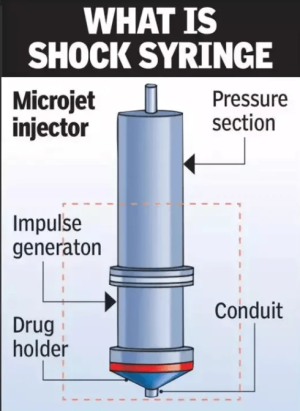Shock Syringe
| Latest News/Current Affairs |
|---|
|

About Shock Syringes
The Shock Syringe refers to a type of injection technology designed to administer drugs or vaccines without the use of traditional needles. These devices use high-pressure systems to force a liquid (such as a vaccine or medication) through the skin via a narrow, high-speed jet of fluid, creating a painless or minimally painful delivery.
It is developed in 2021 in Professor Menezes’s laboratory, is slightly longer than a regular ballpoint pen. This device has a micro shock tube consisting of three sections: the driver, driven, and drug holder, which work together to create the shockwave-driven microjet for drug delivery.
The study, led by Professor Viren Menezes from the Department of Aerospace Engineering, was published in the Journal of Biomedical Materials and Devices.
Working
Unlike normal syringes with needles, these syringes does not rely on piercing the skin with a sharp tip and instead, it uses high-energy pressure waves (shock waves) that can travel faster than the speed of sound to pierce the skin. These waves, when generated, compress the surrounding medium, such as air or liquid, through which they travel.
Pressurised nitrogen gas is applied to the shock syringe that is the driver section of the micro shock tube part; it is filled with liquid drugs to create a microjet of the drug. The microjet travels at a speed nearly twice as fast as a commercial Aeroplane at take-off. This jet stream of drug passes through the nozzle of the syringe before penetrating the skin. The entire process of delivering drugs using a shock syringe is rapid and gentle; most patients wouldn’t feel a thing.
As we can see during a sonic boom when an aircraft flies faster than the speed of sound, it creates shock waves that push and disturb the air and in these syringes, a similar effect happens during its use.

Key Features
- Reducing the risk of needle-stick injuries or reactions or cross-infections.
- Prevent the occurrence of blood-borne diseases caused by needle-stick injuries.
- Uses high-pressure air or a spring-loaded system to force the medication through the skin via a fine, high-speed jet of fluid.
- Designed to reduce fear, discomfort and pain of needle syringes.
- Process more faster than using a needle or traditional syringes.
- Useful for ones who experience fear or anxiety related to needles, mainly children.
- Prevent tissue damage as compared to Traditional syringes.
- Can be helpful for various processes from vaccination to insulin and to some biological drugs.
- Helpful in Emergency Medical Uses or Emergency Medications.
- Could make immunisation drives quicker and more efficient for both children and adults.
- Designed to perform multiple drug delivery shots.
Disadvantages
- Limited Compatibility as not all medications can be delivered effectively via needle-free injectors.
- May lead to minor skin irritations or redness in injection area.
- Problematic for drug addicts and drug mafias who are addicted to drugs and other harmful injectable substances.
- More expensive than normal or traditional syringes.
- May be bulky and difficult to carry or transport.
- User friendly but still proper technique or learning skills needed to use.
- If the injector is not properly aligned, the medication may not be fully delivered into the body.
- May lead to skin reactions or discomfort for those having sensitive skins.
Other Needle-Free Injectors
- Biojector: A well-known brand in the needle-free injector market, which has been used in various medical settings for years.
- Injex: Another popular needle-free injection system that operates via a spring-loaded mechanism.
- Jet Injector Devices: These include technologies that use compressed air to deliver the medication through the skin.
